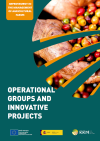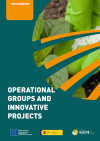Media library
Documentary, graphic and/or audiovisual knowledge objects are offered here, offering information on various sectors and topics. Use the keyword search or search filters to access current audiovisual and documentary knowledge objects useful for your implementation.
If you have any questions or suggestions, please contact us here.
Action plan for the eradication and control of African citrus psyllid (Trioza erytreae) in the Autonomous Community of Cantabria
Trioza erytreae is a pest regulated in the European Union (EU) by Commission Regulation 2019/2072 and is a major vector of the bacterium that causes Huanglongbing (HLB) or citrus greening. HLB, itself a regulated organism in the EU, deteriorates the quality and flavor of the fruit and can kill the affected tree within a few years.
National Contingency Plan for Trioza erytreae
This document sets out the measures to be taken against the African Citrus Psyllium insect, Trioza erytreae (Order: Hemiptera, Superfamily: Psylloidalea, Family: Triozidae), a pest included in the Union's list of quarantine pests by Regulation 2019/2072 and vector of the bacteria that causes Huanglongbing (HLB) or citrus greening.
Contingency Plan for Xanthomonas citri pv. aurantifolii (Schaad et al.) Constantin et al. and Xanthomonas citri pv. citri (Hasse) Constantin et al., which cause Citrus Canker
This document sets out the measures to be taken against the bacterium Xanthomonas citri (pathovars citri and aurantifolii), a quarantine pest, which causes citrus canker, with the aim of preventing its appearance and, if it does appear, acting quickly and effectively, determining its distribution and combating it in order to prevent its spread and eradicate it.
Thaumatotibia leucotreta (Meyrik) Contingency Plan
This document sets out the measures to be adopted against Thaumatotibia leucotreta (codling moth), a pest regulated by the EU as a priority quarantine pest under Implementing Regulation (EU) 2019/2072 and Delegated Regulation (EU) 2019/170.
Candidatus Liberibacter spp. Contingency Plan Bacteria associated with Huanglongbing disease or citrus greening.
This document outlines the measures to be taken against Candidatus Liberibacter spp., bacteria associated with the disease known as Huanglongbing (HLB), or greening, a quarantine organism regulated in the European Union (EU). HLB is considered the most important, serious, and destructive citrus disease worldwide.
Aleurocanthus spiniferus Contingency Plan (Quaintance)
This document sets out the measures to be taken against the quarantine pest Aleurocanthus spiniferus (Quaintance), with the aim of preventing its appearance and, if it does appear, acting quickly and effectively, determining its distribution and combating it in order to try to eradicate it and prevent its spread at all times.
Conotrachelus nenuphar (Herbts) Contingency Plan
This document sets out the measures to be taken against the cucurlionid Conotrachelus nenuphar (Herbts), a priority pest (according to Delegated Regulation (EU) 2019/1702) regulated in the European Union (EU) by Regulation (EU) 2016/2031 and Delegated Regulation (EU) 2019/1702, with the aim of preventing its appearance, and in case it appears, acting quickly and effectively, determining its dis
Contingency Plan for Anoplophora chinensis (Forster) and Anoplophora glabripennis (Motschulsky)
This document sets out the measures to be taken against two species of the genus Anoplophora, organisms regulated in the EU, with the aim of preventing their emergence and, if they do appear, acting quickly and effectively, determining their distribution and combating them with the aim of eradicating them.
Phyllosticta citricarpa (McAlpine) van der Aa Contingency Plan
This document sets out the measures to be taken against citrus black spot, Phyllosticta citricarpa (McAlpine) van der Aa (syn. Guignardia citricarpa), with the aim of preventing its appearance and, if it does appear, acting quickly and effectively, determining its distribution and combating it in order to prevent its spread and eradicate it. P.
Recommended chemical control strategy for citrus plots with Scirtothrips problems
Period from bud break to flowering: The presence of Scirtothrips will be assessed weekly using two main methods: 1. Captures in yellow chromatic traps as an indicator of early presence; these traps require review by specialized technical personnel. 2.
Instructions for the marketing of plants sensitive to Xylella fastidiosa
Chapter VII of Regulation (EU) 2020/1201 on measures to prevent the introduction and spread within the Union of Xylella fastidiosa sets out the requirements for the movement within the EU of specified plants and Chapter VIII sets out the requirements for the introduction into the EU of host plants.
Citrus Whitefly (Dialeurodes citri Ashmead) Treatment Notice
The Plant Health Service monitors the life cycle of this insect in different locations. The pest overwinters in citrus trees in advanced larval stages. A significant percentage of adult whiteflies have emerged, proceeding to lay eggs on young citrus and persimmon leaves. These eggs will give rise to the first generation.
Treatment notice for Pulvinaria polygonata in the Vega Baja and Bajo Vinalopó in citrus groves
Information note on Pulvinaria polygonata in the Vega Baja and Bajo Vinalopó regions. Since the detection of the coccid Pulvinaria polygonata (Cockerell) in citrus plots in the Vega Baja del Segura region in 2019, observations have been made of the behavior of its populations in the area where it has established itself.
Lemon moth Prays citri (Millière) treatment notice on citrus fruits
The lemon moth Prays citri (Millière) is a small lepidopteran that flies at dusk and dawn. Its larvae attack the ovaries of flowers or newly set fruit, causing them to fall and die. The most serious damage is caused to the Verna variety of lemon trees.
National Contingency Plan for Eotetranychus lewisi
This document sets out the measures to be taken against Eotetranychus lewisi, a regulated harmful organism, with the aim of preventing its emergence and, if it does, acting quickly and effectively, determining its distribution and implementing eradication measures. Eotetranychus lewisi is a mite of the Tetranychidae family.
Diaphorina Citri Contingency Plan
This document sets out the measures to be taken against the Asian citrus psyllid, Diaphorina citri (Order: Hemiptera, Family: Psyllidae). This psyllid is included in the EU quarantine pest list by Regulation 2019/2072 as it acts as a vector of the bacterium that causes Huanglongbing (HLB) or citrus greening.
Phytosanitary alert and information network, field protocol for crop monitoring: citrus
Field manual for estimating the risk of damage caused by pests and diseases in citrus crops
Phytosanitary alert and information network, field protocol for crop monitoring: almond
Field manual for estimating the risk of damage caused by pests and diseases in almond cultivation.

Improvement In The Management Of Agricultural Farms. Operational Groups And Innovative Projects
English translation of a compilation of projects developed through Rural Development Programmes, operational groups and innovative projects that are working on issues of improvement in the management of agricultural holdings.

Fertilization. Operational Groups And Innovative Projects
English translation of a compilation of projects developed through the regional and national Rural Development Programmes, operational groups and innovative projects that are working on fertilisation issues.



